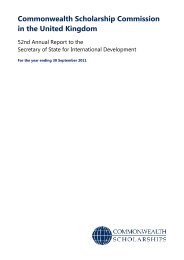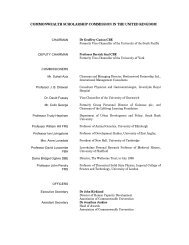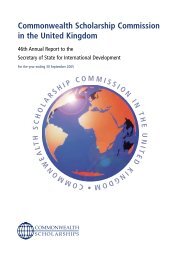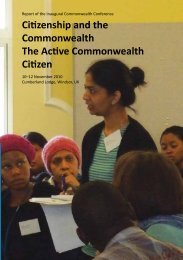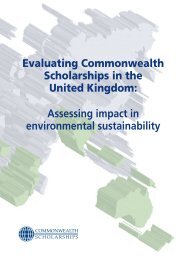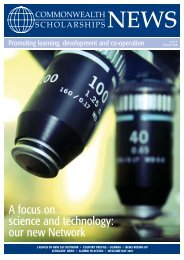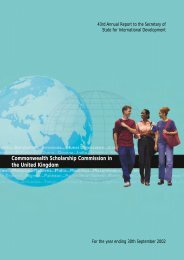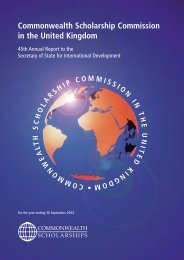Issue 6 - Commonwealth Scholarship Commission in the United ...
Issue 6 - Commonwealth Scholarship Commission in the United ...
Issue 6 - Commonwealth Scholarship Commission in the United ...
Create successful ePaper yourself
Turn your PDF publications into a flip-book with our unique Google optimized e-Paper software.
THE POTENTIAL OF RENEWABLE ENERGY<br />
The Australian government has committed to<br />
<strong>in</strong>creas<strong>in</strong>g <strong>the</strong> supply of renewable electricity to 20%<br />
by 2020, <strong>in</strong> response to <strong>the</strong> challenge posed by<br />
climate change. Australia has traditionally relied on<br />
coal for electricity, mak<strong>in</strong>g up around 70% of supply.<br />
This potentially large <strong>in</strong>crease <strong>in</strong> renewable energy<br />
will place new pressures on <strong>the</strong> transmission grid.<br />
Recognis<strong>in</strong>g this, <strong>the</strong> M<strong>in</strong>isterial Council on Energy is<br />
<strong>in</strong>vestigat<strong>in</strong>g <strong>the</strong> barriers to <strong>in</strong>tegrat<strong>in</strong>g this<br />
renewable energy <strong>in</strong>to <strong>the</strong> electricity market. Antara<br />
Mascarenhas (<strong>Commonwealth</strong> Scholar, MPhil <strong>in</strong><br />
Modern Society and Global Transformations,<br />
University of Cambridge, 2002-2003) is now an<br />
assistant manager <strong>in</strong> <strong>the</strong> federal government. She is<br />
lead<strong>in</strong>g this project, work<strong>in</strong>g with <strong>in</strong>dustry and state<br />
counterparts. As Australia’s transmission grid was<br />
constructed around exist<strong>in</strong>g coal resources, <strong>the</strong>re will<br />
be issues around <strong>the</strong> connection of remote<br />
renewable generation to <strong>the</strong> grid. Many w<strong>in</strong>d and<br />
potential geo<strong>the</strong>rmal (hot-rock) resources are<br />
located remotely from <strong>the</strong> grid.<br />
Antara was a visit<strong>in</strong>g researcher at <strong>the</strong> Massachusetts<br />
Institute of Technology (MIT) <strong>in</strong> July-August 2007,<br />
represent<strong>in</strong>g <strong>the</strong> Australian government. She led a<br />
comparison of <strong>the</strong> Australian electricity market with<br />
that of two American markets (<strong>the</strong> Pennsylvania-<br />
New Jersey-Maryland and New England markets) to<br />
determ<strong>in</strong>e how <strong>the</strong>se markets attract new<br />
<strong>in</strong>vestment <strong>in</strong> electricity generation.<br />
Antara feels that her studies provided her with<br />
some of <strong>the</strong> necessary skills to carry out her<br />
current work. ‘The electricity sector is a real-world<br />
application of <strong>the</strong> academic work I carried out at<br />
Cambridge on how governments and <strong>the</strong><br />
economy <strong>in</strong>teract.’<br />
SOLAR-POWERED LIGHTING PROJECTS IN<br />
MALAWI<br />
Thomas Senganimalunje (<strong>Commonwealth</strong><br />
Scholar, MSc <strong>in</strong> Medical Physics, University of<br />
Leeds, 2004-2005) is now Head of <strong>the</strong> Physics<br />
Department at Chancellor College, University of<br />
Malawi. He is work<strong>in</strong>g on a project to design and<br />
<strong>in</strong>stall solar light<strong>in</strong>g <strong>in</strong> rural secondary schools, a<br />
collaboration between <strong>the</strong> Physics Departments of<br />
<strong>the</strong> University of Malawi and Malasp<strong>in</strong>a University<br />
College <strong>in</strong> Canada.<br />
The LED light<strong>in</strong>g systems consist of three basic<br />
components: LED-light desk lamps, rechargeable<br />
battery power packs, and a solar panel for each<br />
classroom. The system is envisaged for even<strong>in</strong>g<br />
study of 3-hour periods. The f<strong>in</strong>al goal is to design<br />
a system that will be cost effective relative to <strong>the</strong><br />
current costs <strong>in</strong>curred <strong>in</strong> <strong>the</strong> use of kerosene.<br />
A prototype of such a system provid<strong>in</strong>g light<strong>in</strong>g<br />
for six students has already been tested at Msala<br />
Community Day Secondary School <strong>in</strong> 2007. The<br />
full classroom system for 40 students is be<strong>in</strong>g<br />
manufactured and will be <strong>in</strong>stalled <strong>in</strong> May 2008 at<br />
The entrance to <strong>the</strong> Mnajdra temple, one of <strong>the</strong> Megalithic Temples of Malta<br />
<strong>the</strong> same school. The cost of <strong>the</strong> full system is less<br />
than USD 1,000, and <strong>the</strong> break-even po<strong>in</strong>t is at<br />
around three years.<br />
The use of <strong>the</strong> LED system will improve <strong>the</strong><br />
teach<strong>in</strong>g and learn<strong>in</strong>g environment of <strong>the</strong><br />
students through provision of clean and reliable<br />
light<strong>in</strong>g. There will be a reduction of <strong>in</strong>door<br />
pollution from <strong>the</strong> kerosene, whilst <strong>the</strong> light<strong>in</strong>g<br />
costs will be lower.<br />
PRESERVING MALTA’S HERITAGE<br />
The impact of climate change on <strong>the</strong> world’s<br />
cultural properties is an area of grow<strong>in</strong>g concern.<br />
Malta has one of <strong>the</strong> highest densities of<br />
UNESCO World Heritage Sites, and important<br />
monuments <strong>in</strong>clude <strong>the</strong> Megalithic Temples of<br />
Malta, a series of build<strong>in</strong>gs that are over 5,000<br />
years old. These are amongst <strong>the</strong> earliest<br />
structures <strong>in</strong> <strong>the</strong> world to achieve a high level of<br />
architectural sophistication, and climate change<br />
poses a serious threat for such sites. The temples<br />
are built <strong>in</strong> sedimentary limestone, and are very<br />
vulnerable to erosion by <strong>the</strong> elements, susta<strong>in</strong><strong>in</strong>g<br />
severe damage over <strong>the</strong> past century. Climate<br />
change may contribute to an aggravation of<br />
<strong>the</strong>se conservation problems. A major threat to<br />
<strong>the</strong> sites is prolonged and <strong>in</strong>tense ra<strong>in</strong>fall, which<br />
has previously led to <strong>the</strong> collapse of sections of<br />
<strong>the</strong> megalithic walls. If precipitation becomes<br />
more <strong>in</strong>tense, this will have a direct effect on <strong>the</strong><br />
conservation of <strong>the</strong> monuments.<br />
Dr Reuben Grima (<strong>Commonwealth</strong> Scholar, PhD<br />
<strong>in</strong> Archaeological Site Management, Institute of<br />
Archaeology, University College London, 2000-<br />
2003) is a Senior Curator of Prehistoric Sites at<br />
Heritage Malta, <strong>the</strong> national agency responsible<br />
for manag<strong>in</strong>g museums and archaeological sites.<br />
He is currently lead<strong>in</strong>g a project, funded by <strong>the</strong><br />
European <strong>Commission</strong>, to <strong>in</strong>stall protective<br />
shelters over two of <strong>the</strong> temple sites. This is part<br />
of an <strong>in</strong>tensive environmental monitor<strong>in</strong>g<br />
programme, <strong>in</strong> collaboration with Italy’s Institute<br />
for Atmospheric Sciences and Climate (ISAC).<br />
© Joonas L<strong>in</strong>dholm<br />
SUSTAINABLE DEVELOPMENT, CLIMATE<br />
CHANGE AND THE ECOHEALTH FRAMEWORK<br />
Global ecological <strong>in</strong>tegrity and susta<strong>in</strong>able<br />
development are <strong>in</strong>creas<strong>in</strong>gly salient issues for <strong>the</strong><br />
public health community, and it is commonly<br />
recognised that human<br />
health is enhanced<br />
with<strong>in</strong> socially and<br />
ecologically <strong>in</strong>tact<br />
environments.<br />
Maya Gislason is a<br />
<strong>Commonwealth</strong><br />
Scholar from Canada,<br />
Maya Gislason<br />
study<strong>in</strong>g for a DPhil <strong>in</strong><br />
<strong>Commonwealth</strong> Scholar <strong>the</strong> Sociology of Health<br />
from Canada<br />
and Illness at <strong>the</strong><br />
University of Sussex. As<br />
a medical sociologist,<br />
her doctoral research explores how <strong>the</strong> effects of<br />
climate change are constructed and contested as<br />
health determ<strong>in</strong>ants with<strong>in</strong> new public health policy<br />
and practice <strong>in</strong>itiatives. Her research is premised on<br />
<strong>the</strong> EcoHealth observation that neoclassical<br />
economic approaches to susta<strong>in</strong>able development<br />
do not sufficiently promote practices that susta<strong>in</strong> <strong>the</strong><br />
earth’s life support systems.<br />
The urgency of climate change may <strong>in</strong>spire <strong>the</strong><br />
development of effective transnational<br />
environmental public health policies and healthy<br />
communities and cities <strong>in</strong> which people work to<br />
produce local and global ecological and social health<br />
and wellbe<strong>in</strong>g. Practices such as buy<strong>in</strong>g local organic<br />
food, us<strong>in</strong>g susta<strong>in</strong>able modes of transportation and<br />
recycl<strong>in</strong>g are all concrete actions that <strong>in</strong>dividuals can<br />
take. Concretely, through <strong>the</strong>se simple localised<br />
activities <strong>the</strong> overall anthropogenic stress on <strong>the</strong><br />
planet is reduced and conceptually ideas about<br />
susta<strong>in</strong>able development and health are re-imag<strong>in</strong>ed.<br />
Understand<strong>in</strong>g <strong>the</strong> l<strong>in</strong>ks between global<br />
environmental change and human health risks<br />
creates a unique opportunity for people to create a<br />
new paradigm where meet<strong>in</strong>g human goals <strong>in</strong>volves<br />
ma<strong>in</strong>ta<strong>in</strong><strong>in</strong>g <strong>the</strong> <strong>in</strong>tegrity of our life support systems.<br />
May 2008 7



